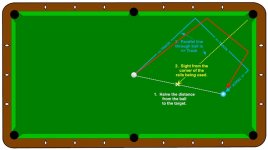MitchAlsup:
For two rail kicks. Imagine a line between the CB and the OB and find the exact middle of this line. From this point aim at a pocket (90% corner but occasionaly a side). This aim line is now transfered to the CB (that is moved while retaining the same angular relationship) and becomes the point of aim for the CB. Use a touch of running english.
I picked this up by watching WPBA.
Mr Hoppe:
This is a seldom documented, but VERY easy and repeatible method for 2 rail kicks. Easy and works well, but hard to get real accuracy on the hit. This is the nuts if you just want to make the hit.

![CropperCapture[16].png CropperCapture[16].png](https://forums.azbilliards.com/data/attachments/111/111446-4c76d2810039122edf295022f37c47f5.jpg?hash=THbSgQA5Ei)